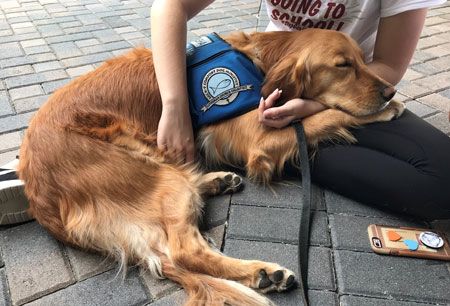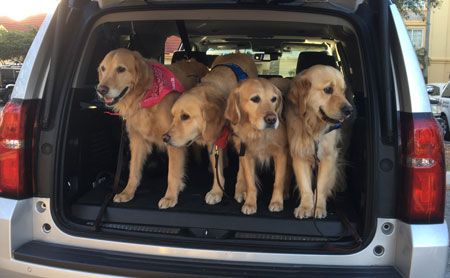A helping paw: comfort within crisis
Within the aftermath of a tragic event or natural disaster, Lutheran Church Charities' K-9 Comfort Dog Ministry helps bring light back into the victims' dark world.

One of LCC's comfort dogs, Sasha, relaxes with a Stoneman Douglas High School student in Parkland, Florida. Photo courtesy of Lutheran Church Charities In the dark wake of disaster, a numbness spreads over the people affected. Whether it's a natural disaster or a manmade tragedy, the light leaves people's eyes and they're left feeling isolated, alone and in need of someone to help them back to their feet. They need someone to listen, care and give love without judgment.
The comfort dogs of Lutheran Church Charities (LCC) serve just that purpose.
The beginning of hope
It started in 2008, recalls President and CEO Tim Hetzner, with four golden retrievers and a relief mission just outside New Orleans, Louisiana: “When Hurricane Katrina hit, FEMA asked if we could do search and rescue for people and their pets. It was there on those lifeboats that we saw the magical therapy of a person with a pet going through crisis. They were willing to risk their lives rather than part with their pets.”
After that, Hetzner says the call to action for LCC K-9 Comfort Dog Ministry was explosive. “Now we have about 130 dogs in 20 states. If there's a crisis or disaster, we deploy our dogs and handlers from all over. For instance, 19 dogs from 10 different states are in Florida right now to comfort those affected by the school shooting.”
Practiced comfort
The dogs are trained by the organization, for the organization. From the time the dogs-all American Kennel Club-registered golden retrievers-are 8 weeks old, they're trained for 16 to 18 months. They work with multiple handlers to prepare them to visit places with any number of people. They're trained not to be spooked by noises like gunshots-“They visit military funerals, which often have 21-gun salutes,” Hetzner explains-and learn to be comfortable around people of all ages, shapes and sizes.
The directives of the handlers and comfort dogs of Lutheran Church Charities are simple. “Boots and paws on the ground within 24 hours of an invitation,” Hetzner says. “We never charge those we serve. We pick up all of our transportation, food and lodgings so there's no burden on the people in the midst of a crisis. As a faith ministry, we're there to bring mercy and compassion to people going through dark times. But the key is the dogs.”
Where people affected by crisis might not open up to the people around them, Hetzner says it's a different story with the organization's comfort dogs. “Many times they'll talk to the dogs first,” he explains. “They're good listeners, they don't take notes, they're confidential.” He says the dogs become a type of counselor, and each of the 130 dogs have their own Facebook account, email address and other means of contact and communication so they can extend comfort even after they've left the site of the disaster. “The handler, of course, has to type the responses,” Hetzner confides.
And, according to Hetzner, this quiet counseling happens wherever the dogs are called-and they've been called seemingly everywhere. They've traveled to comfort the victims of the Las Vegas, Orlando and Sandy Hook shootings, as well as other major tragic events like the Boston Marathon bombing. Today, the dogs are in Parkland, Florida, while another dispatch of dogs is on its way to victims of river flooding in Illinois, near where the organization is based in Northbrook, Illinois. Suffice to say, the dogs and their handlers have their work cut out for them.

Pictured from left to right: Hannah, Tobias, Ruthie and Jacob are ready to bring comfort to those in need. Photo courtesy of Lutheran Church Charities The care of the caregivers
With the work cut out for them comes risk, of course. Hetzner agrees wholeheartedly. “The dogs take on the emotions of the people petting them,” he says. “Which is why we have a veterinarian out with us. And the handlers know their dogs. They know when they've had enough and need a break.” He explains that the dogs are only working with victims for an hour, then their vests are removed and they have ample time to play and run with their handlers before the vests need to go back on.
“We very intently take care of these dogs and their emotional well-being,” Hetzner says. “And the same goes for our handlers.” He says compassion fatigue is common within the people of the organization alongside the dogs they work with. “We debrief every night to talk about the day,” Hetzner explains. “People talk about what happened and we make sure our humans are good with it all.”
As far as physical and behavioral health go, Hetzner says they pull out all the stops. “People usually ask how many years we work the dogs, and I say we leave that up to the veterinarian because the health and well-being of the dog is key to us. When the vet says they should be retired, that's what we do. Whatever's best for the dog.” He explains that he is constantly in contact with John Collister, DVM, PhD, an associate professor at the University of Minnesota College of Veterinary Medicine. He also will not let a service dog be placed until it's been examined by a veterinarian working with the organization.
“We never kennel the dogs,” Hetzner says. “They fly with us. Each dog has two caregivers: a primary and secondary. We don't use treats, and we feed them only high-quality food. Grooming, care and regular veterinary visits are so important to us-we don't want to wait until there's a health issue. And the veterinarians have been wonderful. In most cases, they service our dogs for free or at cost. But most vets like dogs, y'know, and we like them.”
It's an awful lot of time and care that goes into the comfort dogs, but Hetzner believes it's all worth it. “We invest a lot in these dogs,” he agrees, “but they touch thousands of lives. Mercy, compassion and care are so important in times like this-it shows the world isn't evil. There's good still in it, and people need to see that there's hope.”
That moment of connection
When people in crisis go numb, Hetzner says no matter what their face shows, you can always see the truth in their eyes-and most victims' eyes hold layers of hopelessness. “But every time they see one of our dogs, you see the miracle of their eyes lighting up. The dogs sit or lay, and the people will lay on them like a comfort rug with a heartbeat. And then they'll talk to the dog. And then they'll start smiling, and there's hope again.”







